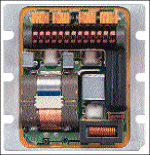2nd-generation dc/dc converters
slash parts count and cost
High-power, high-density dc/dc converters underwent a significant advance
last year with Vicor's VI-300 series. Heralded as the second generation
of high-density converters, the VI-300 series enables designers to build
state-of-the-art power systems with higher performance and power output
in a smaller size than previously possible, at a cost competitive with
other high-power, high-density dc/dc converters.
The converters achieve the dramatic size and cost reductions through
advances in silicon integration and use of a patented zero-current- and
zero-voltage-switching architecture. The series represents the first significant
advance in high-density dc/dc converters since the company originally pioneered
the technology over a decade ago and spawned development of similar products
from other power supply makers.
Offered initially in three models rated 150, 400, and 600 W, the VI-300
series converters have one-third the parts count and are half the price
of their first-generation predecessors–the VI-200 series. In addition,
they use a power-sharing scheme that simplifies development of fault-tolerant
power systems. The converters have watt-densities exceeding 80 W/in.3
and are priced from well under $1 per watt.

Using extensive silicon integration and a patented
circuit architecture, Vicor's VI-300 series dc/dc
converters give power system designers higher
performance and power output in a smaller size than
previously possible, at a cost competitive with
other high-density converters.
All of the converters' control functions and active circuitry are packaged
into just two ICs occupying less than 0.1 in.3 Besides the two
ICs required for primary and secondary intelligence, a discrete resistor
or capacitor sets each operating parameter, such as maximum switching frequency,
maximum switch-on time, and over-temperature shutdown.
The converter's innovative n + m fault-tolerant architecture elects
one module as the master upon startup with the other modules synchronized
to it. Based on an input-side digital bus, the architecture maintains continuous
power system operation without the need for separate driver and booster
modules.
Of the three VI-300 series converters, the 150-W Model V48C12C150A converter
comes in a new microsized package measuring 1.45 x 2.28 x 0.5 in., one-third
the size of the first-generation VI-200 module. It accepts a 36 to 75-Vdc
input and provides a 12-Vdc output.
The 400-W Model V48C12C150A and the 600-W Model V375A48C600A accept
a 375-Vdc input and provide 5- and 48-Vdc outputs, respectively. They occupy
the same 4.6 x 2.2 x 0.5-in. package of the previous-generation VI-200
module, which is rated at 200 W. (Model V48C12C150A, $112; Model V375A5C400A,
$180; Model V375A-48C600A, $248–stock.)
Vicor
Andover, MA
Vicor Express 800-735-6200
Advertisement





